Cassava Cultivation Guide:
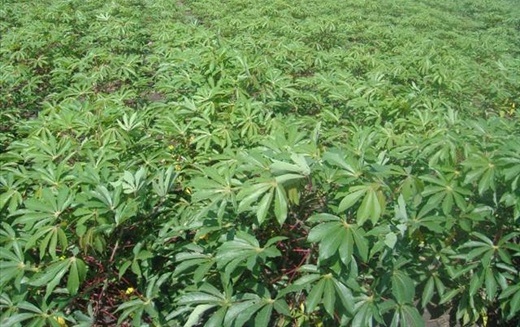
Introduction of Cassava Cultivation:- Cassava is similar to other tuber crops like yam and sweet potato. This vegetable is grown mainly for its tubers. The cassava plant is a woody plant with erect stems and spirally arranged simple lobed leaves with petioles (leaf stems) up to 30 cm in length. The plant produces petal-less flowers on a raceme. The edible roots of the plant are usually cylindrical and tapered and are white, brown or reddish in color. Cassava plants can reach 4 meter in height Cassava is popularly called as “tapioca” or “yucca” or “manioc” and it produces more calories per unit area. Cassava can be processed into a number of products such as starch, flour, chips, ethanol and glucose syrup, and bread to name a few. These products have high demand locally and also have significant export possibilities. Cassava belongs to the family of “Euphorbiaceae” and genus of “Manihot”. The cassava plant has its origin in South America. The cassava was used by Amazon Indians instead of or in addition to rice, potato or maize. Now the cassava crop is cultivated across most of the tropical regions in the world. Today Nigeria and Congo-Kinshasa are the biggest producers of cassava after Brazil and Thailand. Cassava has good health benefits and the leaves of the plant are also full of nutrition. This crop is a cash crop and can achieve good yield and profits for farmers with crop management practices.
Health Benefits of Cassava:-The following are the health benefits of cassava.
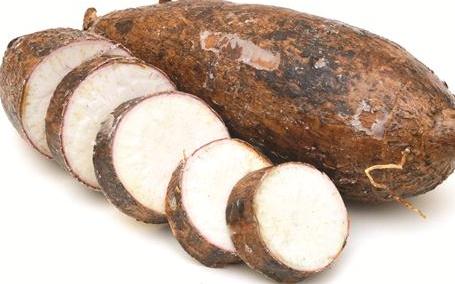
- Cassava is a good source of energy since it contains good amount of carbohydrates.
- Cassava is a good source of calcium, phosphorus, manganese, iron and potassium.
- Cassava contains high amounts of dietary fiber.
- Cassava is gluten-free tuber.
- Cassava may help in lowering unhealthy cholesterol levels in the blood.
- Cassava may slow down ageing.
- Cassava helps in Alzheimer’s patients.
- Cassava increases immune function.
Main Production States of Cassava in India:- Tamil Nadu, Kerala, Andhra Pradesh, Nagaland, Meghalaya, Assam and Karnataka.
Local Names of Cassava in India:- कसावा, Sakarkand (Hindi), Karra pendalam (Telugu), மரவள்ளி (Tamil), Maricheeni or Kappa (Malayalam), Kondho moolo (Oriya), Mogo (Gujarati), ಮರಗೆಣಸು (Kannada).
Varieties of Cassava:- There are many improved cassava varieties (cultivars) being cultivated in different regions of India. The following are the important varieties among all;CO-1,CO-2,CO-3,H-97, H-165,H-226,KMC-1, M4, Nidhi, Sree Harsha, Sree Praksh, Sree Sahya and Sree Visakham.
Climate and Soil Requirement for Cassava Cultivation:- Cassava is a tropical root crop, requiring at least 8 months of warm weather to produce a crop. It can be grown in extremes of rainfall. In most regions, it does not tolerate flooding. In droughty areas it loses its leaves to conserve moisture, producing new leaves when rains resume. It takes 18 or more months to produce a crop under adverse conditions such as cool or dry weather. Cassava does not tolerate freezing conditions and produce poor yield. It tolerates a wide range of soil pH 4.5 to 8.0 and is most productive in full sun.
Propagation in Cassava Cultivation:- Cassava mostly propagated vegetatively (stem cuttings) by planting a piece of the stalk, which then grows into a new plant.
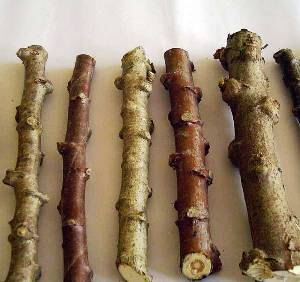
Land Preparation, Planting Methods in Cassava Cultivation:- Cassava can be cultivated under both irrigated and rainfed conditions. Under irrigated conditions, this crop can be cultivated throughout the year whereas under rainfed conditions; May-June is best time before monsoon season starts. Planting cassava without prior tillage in degraded soils may produce lower yields in the initial years; once soil health is restored, however, untilled land can produce high yields at a lower cost to the farmer and the farm’s natural resources. Mulch and cover crops help to reduce weed infestations and create soil conditions that improve yield. Loosening the soil to a depth of 20 to 25 cm either by tractor ploughing is recommended.
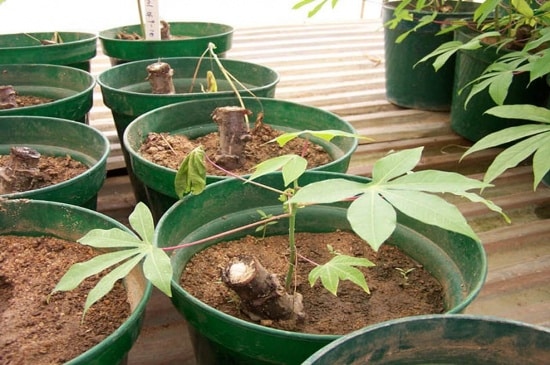
While preparing the land, depending on the soil situation, different methods are followed. In case of light textured soils, flat method; In case of heavy textured soils, mound method is being practiced. In case of irrigated conditions, furrow and ridge methods are being followed.
When it comes to planting material, it is recommended to plant disease and insect free plants of 8 to 9 months old having thickness of 2 to 3 cm. In order to make better stakes (stem cuttings) or root yield, stakes obtained from bottom and middle portion of the stem after discarding 1/3rd from the total length of the stem from the top are preferred. Prepare the stakes of smooth and circular cut instead of irregular cut.
A stake length of 25 to 30 cm should be beneficial and shallow planting allows producing more number of roots. After making the soil loose enough and friable, stakes (stem cuttings) can be planted @ 5cm depth. Avoid planting the stakes deeper in the soil as it may result in swelling of the stem and results in poor yield.
When it comes to method of planting in cassava cultivation, vertical, slanted, and horizontal can be practiced. However, vertical planting is recommended as it results in more uniform formation of callus tissue around the cut surface and this helps in forming the tubers uniformly all around the base of the cassava plant.
Spacing and plant density in cassava cultivation depends on the cassava genotypes. Non branched types require 75 x 75 cm, semi branched and branched type requires 90 x 90 cm for best tuber yield. Planting one stake per hill is recommended. However, 2 stakes per hill may increase the yield but reduce the tuber size which may not be good for export market quality. Excess sprouts should be removed and try to retain 2 per plant at opposite sides is better for allowing to produce more number of tubers per plant.
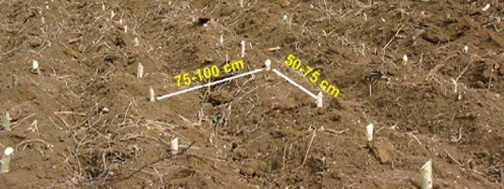
As part of the gap filling in cassava cultivation, it is recommended to grow 5 to 6% of the stakes separately in nursery at close spacing as all the stakes planted in the main field may not establish properly for different reasons (due to low quality planting material and adverse climatic conditions).
Manures and Fertilizers in Cassava Cultivation:- For high yielding hybrid or improved varieties, a basal dose of 15 tonnes of farmyard manure (FMY) along with a chemical fertilizers of Nitrogen ( N:50kg), Phosphorus (P:50kg) and Potash (P:50kg) per hectare should be applied at the time of land preparation. Subsequently, a dose of 50 kg ‘N’ and 50 kg of ‘’P’ should be applied along with the first intercultural operations 50 to 60 days after planting in the field.
Irrigation in Cassava Cultivation:- This tropical crop can be cultivated as rain-fed and irrigated. However, it is essential to have sufficient moisture in the initial 3 weeks period to establish the stake cuttings and produce healthy tubers. In drought conditions, provide frequent irrigation for proper growth of cassava tubers. Under irrigated conditions, scheduling of irrigation 25% available moisture depletion throughout the growing season could double the tuber production.
Intercropping in Cassava Cultivation:- During initial 2 to 3 months of planting, short duration intercrops like any leguminous crops can be cultivated. Application of fertilizers and irrigation should be additional when going for intercropping.
Intercultural operations in Cassava Cultivation:- Regular weeding should be carried out and any dried or diseased branches can be removed. Mulching is the best way to control the weed growth for couple of months and conserve the soil moisture as well.
Pests and Diseases in Cassava Cultivation:- The following are the common pests and diseases found in cassava cultivation;Cassava mosaic, Cassava bacterial blight, Anthracnose, Bud necrosis, Brown leaf spot, White leaf spot, Cassava brown streak disease, Cassava root rot disease, African root and tuber scale, Two-spotted spider mite, Cassava green spider mite, Grasshoppers, Cassava scale, Root knot nematode and Witches’ broom.
For control measures of these pests and disease in cassava farming, contact local agriculture department or any agriculture university.
Harvesting and Yield in Cassava Cultivation:- The cassava crop is ready after 10 to 12 months of planting and short duration crops may be ready in 6 to 7 months after planting. Harvesting in right time is more important as delay may result in low quality of tubers.. Mostly, cassava is harvested by hand, lifting the lower part of stem and pulling the roots out of the ground, then removing them from the base of the plant by hand. The upper parts of the stems with the leaves should be removed before harvest. Levers and ropes can be used to assist harvesting. Care should be taken otherwise roots may be damaged.
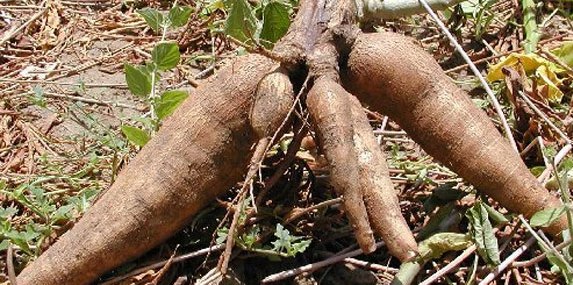
Yield of tubers depends on many factors including farm management practices, climatic conditions and cultivar chosen. Usually, Hybrid/high yielding varieties produce 30 to 40 tonnes per hectare where as short duration may produce 25 to 30 tonnes/ha.
For Asia Farming: Read here.
For Sheep or Goat Farming : Read here.
Very nicely explained!
I now have the full knowledge on how to cultivate cassava. Its well explained and very easy to demonstrate.
I did IT but my main interest is Aquaculture. Integrating fish farming and cassava farming.
very educative. I have learned new techniques today. Thanks
I am farming tapiaco for the past two years in approximately 10 acres. I learned a lot by experience and more about the mistakes I made in the past, by reading this article.
G.Gopalan
I want to learn skills of cultivating casava and much more it’s uses.